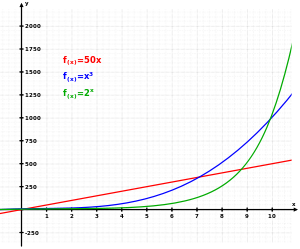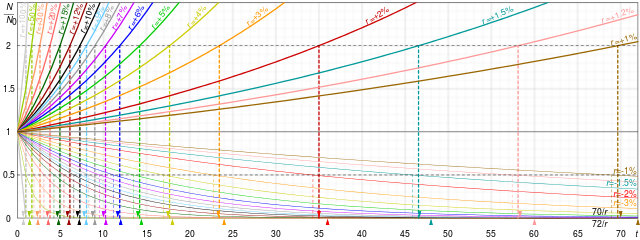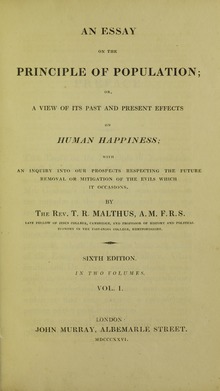The term cell growth is used in the contexts of biological cell development and cell division (reproduction). When used in the context of cell development, the term refers to increase in cytoplasmic and organelle volume (G1 phase), as well as increase in genetic material (G2 phase) following the replication during S phase. This is not to be confused with growth in the context of cell division, referred to as proliferation, where a cell, known as the "mother cell", grows and divides to produce two "daughter cells" (M phase).
Cell populations
Cell populations go through a particular type of exponential growth called doubling. Thus, each generation
of cells should be twice as numerous as the previous generation.
However, the number of generations only gives a maximum figure as not
all cells survive in each generation.
Cell size
Cell size is highly variable among organisms, with some algae such as Caulerpa taxifolia being a single cell several meters in length. Plant cells are much larger than animal cells, and protists such as Paramecium
can be 330 μm long, while a typical human cell might be 10 μm. How
these cells "decide" how big they should be before dividing is an open
question. Chemical gradients are known to be partly responsible, and it
is hypothesized that mechanical stress detection by cytoskeletal structures is involved. Work on the topic generally requires an organism whose cell cycle is well-characterized.
Yeast cell size regulation
The relationship between cell size and cell division has been extensively studied in yeast.
For some cells, there is a mechanism by which cell division is not
initiated until a cell has reached a certain size. If the nutrient
supply is restricted (after time t = 2 in the diagram, below), and the
rate of increase in cell size is slowed, the time period between cell
divisions is increased. Yeast cell-size mutants were isolated that begin cell division before reaching a normal/regular size (wee mutants).
Figure 1:Cell cycle and growth
Wee1 protein is a tyrosine kinase that normally phosphorylates the Cdc2 cell cycle regulatory protein (the homolog of CDK1
in humans), a cyclin-dependent kinase, on a tyrosine residue. Cdc2
drives entry into mitosis by phosphorylating a wide range of targets.
This covalent
modification of the molecular structure of Cdc2 inhibits the enzymatic
activity of Cdc2 and prevents cell division. Wee1 acts to keep Cdc2
inactive during early G2 when cells are still small. When cells have reached sufficient size during G2, the phosphatase Cdc25
removes the inhibitory phosphorylation, and thus activates Cdc2 to
allow mitotic entry. A balance of Wee1 and Cdc25 activity with changes
in cell size is coordinated by the mitotic entry control system. It has
been shown in Wee1 mutants, cells with weakened Wee1 activity, that
Cdc2 becomes active when the cell is smaller. Thus, mitosis occurs
before the yeast reach their normal size. This suggests that cell
division may be regulated in part by dilution of Wee1 protein in cells
as they grow larger.
Linking Cdr2 to Wee1
The protein kinase Cdr2 (which negatively regulates Wee1) and the Cdr2-related kinase Cdr1 (which directly phosphorylates and inhibits Wee1 in vitro)
are localized to a band of cortical nodes in the middle of interphase
cells. After entry into mitosis, cytokinesis factors such as myosin II are recruited to similar nodes; these nodes eventually condense to form the cytokinetic ring. A previously un-characterized protein, Blt1,
was found to co-localize with Cdr2 in the medial interphase nodes. Blt1
knockout cells had increased length at division, which is consistent
with a delay in mitotic entry. This finding connects a physical
location, a band of cortical nodes, with factors that have been shown to
directly regulate mitotic entry, namely Cdr1, Cdr2, and Blt1.
Further experimentation with GFP-tagged
proteins and mutant proteins indicates that the medial cortical nodes
are formed by the ordered, Cdr2-dependent assembly of multiple
interacting proteins during interphase. Cdr2 is at the top of this
hierarchy and works upstream of Cdr1 and Blt1.
Mitosis is promoted by the negative regulation of Wee1 by Cdr2. It
has also been shown that Cdr2 recruits Wee1 to the medial cortical node.
The mechanism of this recruitment has yet to be discovered. A Cdr2
kinase mutant, which is able to localize properly despite a loss of
function in phosphorylation, disrupts the recruitment of Wee1 to the
medial cortex and delays entry into mitosis. Thus, Wee1 localizes with
its inhibitory network, which demonstrates that mitosis is controlled
through Cdr2-dependent negative regulation of Wee1 at the medial
cortical nodes.
Cell polarity factors
Cell
polarity factors positioned at the cell tips provide spatial cues to
limit Cdr2 distribution to the cell middle. In fission yeast Schizosaccharomyces pombe (S. Pombe), cells divide at a defined, reproducible size during mitosis because of the regulated activity of Cdk1. The cell polarity protein kinase Pom1,
a member of the dual-specificity tyrosine-phosphorylation regulated
kinase (DYRK) family of kinases, localizes to cell ends. In Pom1
knockout cells, Cdr2 was no longer restricted to the cell middle, but
was seen diffusely through half of the cell. From this data it becomes
apparent that Pom1 provides inhibitory signals that confine Cdr2 to the
middle of the cell. It has been further shown that Pom1-dependent
signals lead to the phosphorylation of Cdr2. Pom1 knockout cells were
also shown to divide at a smaller size than wild-type, which indicates a
premature entry into mitosis.
Pom1 forms polar gradients that peak at cell ends, which shows a
direct link between size control factors and a specific physical
location in the cell.
As a cell grows in size, a gradient in Pom1 grows. When cells are
small, Pom1 is spread diffusely throughout the cell body. As the cell
increases in size, Pom1 concentration decreases in the middle and
becomes concentrated at cell ends. Small cells in early G2 which
contain sufficient levels of Pom1 in the entirety of the cell have
inactive Cdr2 and cannot enter mitosis. It is not until the cells grow
into late G2, when Pom1 is confined to the cell ends that Cdr2 in the
medial cortical nodes is activated and able to start the inhibition of
Wee1. This finding shows how cell size plays a direct role in
regulating the start of mitosis. In this model, Pom1 acts as a
molecular link between cell growth and mitotic entry through a
Cdr2-Cdr1-Wee1-Cdk1 pathway.
The Pom1 polar gradient successfully relays information about cell
size and geometry to the Cdk1 regulatory system. Through this gradient,
the cell ensures it has reached a defined, sufficient size to enter
mitosis.
Cell cycle regulation in mammals
Many
different types of eukaryotic cells undergo size-dependent transitions
during the cell cycle. These transitions are controlled by the
cyclin-dependent kinase Cdk1.
Though the proteins that control Cdk1 are well understood, their
connection to mechanisms monitoring cell size remains elusive.
A postulated model for mammalian size control situates mass as the
driving force of the cell cycle. A cell is unable to grow to an
abnormally large size because at a certain cell size or cell mass, the S
phase is initiated. The S phase starts the sequence of events leading
to mitosis and cytokinesis. A cell is unable to get too small because
the later cell cycle events, such as S, G2, and M, are delayed until
mass increases sufficiently to begin S phase.
Many of the signal molecules that convey information to cells
during the control of cellular differentiation or growth are called growth factors. The protein mTOR is a serine/threonine kinase that regulates
translation and cell division. Nutrient availability influences mTOR
so that when cells are not able to grow to normal size they will not
undergo cell division.
The details of the molecular mechanisms of mammalian cell size control
are currently being investigated. The size of post-mitotic neurons
depends on the size of the cell body, axon and dendrites. In
vertebrates, neuron size is often a reflection of the number of
synaptic contacts onto the neuron or from a neuron onto other cells.
For example, the size of motoneurons usually reflects the size of
the motor unit that is controlled by the motoneuron.
Invertebrates often have giant neurons and axons that provide
special functions such as rapid action potential propagation.
Mammals also use this trick for increasing the speed of signals in the
nervous system, but they can also use myelin to accomplish this, so
most human neurons are relatively small cells.
Other experimental systems for the study of cell size regulation
One common means to produce very large cells is by cell fusion to form syncytia. For example, very long (several inches) skeletal muscle cells are formed by fusion of thousands of myocytes. Genetic studies of the fruit fly Drosophila have revealed several genes that are required for the formation of multinucleated muscle cells by fusion of myoblasts. Some of the key proteins are important for cell adhesion between myocytes and some are involved in adhesion-dependent cell-to-cell signal transduction that allows for a cascade of cell fusion events.
Oocytes
can be unusually large cells in species for which embryonic development
takes place away from the mother's body. Their large size can be
achieved either by pumping in cytosolic components from adjacent cells
through cytoplasmic bridges (Drosophila) or by internalization of nutrient storage granules (yolk granules) by endocytosis (frogs).
Increases in the size of plant cells are complicated by the fact that almost all plant cells are inside of a solid cell wall.
Under the influence of certain plant hormones the cell wall can be
remodeled, allowing for increases in cell size that are important for
the growth of some plant tissues.
Most unicellular organisms are microscopic in size, but there are some giant bacteria and protozoa that are visible to the naked eye. See: Table of cell sizes —Dense populations of a giant sulfur bacterium in Namibian shelf sediments — Large protists of the genus Chaos, closely related to the genus Amoeba.
In the rod-shaped bacteria E. coli, Caulobacter crescentus and B. subtilis
cell size is controlled by a simple mechanisms in which cell division
occurs after a constant volume has been added since the previous
division.
By always growing by the same amount, cells born smaller or larger than
average naturally converge to an average size equivalent to the amount
added during each generation.
Cell division
Cell reproduction is asexual. For most of the constituents of the cell, growth is a steady, continuous process, interrupted only briefly at M phase when the nucleus and then the cell divide in two.
The process of cell division, called cell cycle, has four major parts called phases. The first part, called G1 phase is marked by synthesis of various enzymes that are required for DNA replication.
The second part of the cell cycle is the S phase, where DNA replication produces two identical sets of chromosomes. The third part is the G2 phase in which a significant protein synthesis occurs, mainly involving the production of microtubules that are required during the process of division, called mitosis.
The fourth phase, M phase, consists of nuclear division (karyokinesis) and cytoplasmic division (cytokinesis), accompanied by the formation of a new cell membrane.
This is the physical division of "mother" and "daughter" cells. The M
phase has been broken down into several distinct phases, sequentially
known as prophase, prometaphase, metaphase, anaphase and telophase leading to cytokinesis.
Cell division is more complex in eukaryotes than in other organisms. Prokaryotic cells such as bacterial cells reproduce by binary fission, a process that includes DNA replication, chromosome segregation, and cytokinesis. Eukaryotic cell division either involves mitosis or a more complex process called meiosis. Mitosis and meiosis are sometimes called the two "nuclear
division" processes. Binary fission is similar to eukaryote cell
reproduction that involves mitosis. Both lead to the production of two
daughter cells with the same number of chromosomes as the parental cell.
Meiosis is used for a special cell reproduction process of diploid organisms. It produces four special daughter cells (gametes) which have half the normal cellular amount of DNA. A male and a female gamete can then combine to produce a zygote, a cell which again has the normal amount of chromosomes.
The rest of this article is a comparison of the main features of
the three types of cell reproduction that either involve binary fission,
mitosis, or meiosis. The diagram below depicts the similarities and
differences of these three types of cell reproduction.
Cell growth
Comparison of the three types of cell division
The DNA content of a cell is duplicated at the start of the cell reproduction process. Prior to DNA replication, the DNA content of a cell can be represented as the amount Z (the cell has Z chromosomes). After the DNA replication process, the amount of DNA in the cell is 2Z
(multiplication: 2 x Z = 2Z). During Binary fission and mitosis the
duplicated DNA content of the reproducing parental cell is separated
into two equal halves that are destined to end up in the two daughter
cells. The final part of the cell reproduction process is cell division,
when daughter cells physically split apart from a parental cell.
During meiosis, there are two cell division steps that together produce
the four daughter cells.
After the completion of binary fission or cell reproduction involving mitosis, each daughter cell has the same amount of DNA (Z)
as what the parental cell had before it replicated its DNA. These two
types of cell reproduction produced two daughter cells that have the
same number of chromosomes as the parental cell. Chromosomes duplicate
prior to cell division when forming new skin cells for reproduction.
After meiotic cell reproduction the four daughter cells have half the
number of chromosomes that the parental cell originally had. This is the
haploid amount of DNA, often symbolized as N. Meiosis is used by diploid
organisms to produce haploid gametes. In a diploid organism such as the
human organism, most cells of the body have the diploid amount of DNA,
2N. Using this notation for counting chromosomes we say that human somatic cells have 46 chromosomes (2N = 46) while human sperm and eggs have 23 chromosomes (N = 23). Humans have 23 distinct types of chromosomes, the 22 autosomes and the special category of sex chromosomes.
There are two distinct sex chromosomes, the X chromosome and the Y
chromosome. A diploid human cell has 23 chromosomes from that person's
father and 23 from the mother. That is, your body has two copies of
human chromosome number 2, one from each of your parents.
Chromosomes
Immediately after DNA replication a human cell will have 46 "double
chromosomes". In each double chromosome there are two copies of that
chromosome's DNA molecule. During mitosis the double chromosomes are
split to produce 92 "single chromosomes", half of which go into each
daughter cell. During meiosis, there are two chromosome separation steps
which assure that each of the four daughter cells gets one copy of each
of the 23 types of chromosome.
Sexual reproduction
Though cell reproduction that uses mitosis can reproduce eukaryotic
cells, eukaryotes bother with the more complicated process of meiosis
because sexual reproduction such as meiosis confers a selective advantage.
Notice that when meiosis starts, the two copies of sister chromatids
number 2 are adjacent to each other. During this time, there can be genetic recombination
events. Parts of the chromosome 2 DNA gained from one parent (red) will
swap over to the chromosome 2 DNA molecule that received from the other
parent (green). Notice that in mitosis the two copies of chromosome
number 2 do not interact. It is these new combinations of parts of
chromosomes that provide the major advantage for sexually reproducing
organisms by allowing for new combinations of genes and more efficient evolution.
However, in organisms with more than one set of chromosomes at the main
life cycle stage, sex may also provide an advantage because, under
random mating, it produces homozygotes and heterozygotes according to the Hardy-Weinberg ratio.
Disorders
A series of growth disorders can occur at the cellular level and these consequently underpin much of the subsequent course in cancer, in which a group of cells display uncontrolled growth and division beyond the normal limits, invasion (intrusion on and destruction of adjacent tissues), and sometimes metastasis (spread to other locations in the body via lymph or blood).
Measurement methods
The cell growth can be detected by a variety of methods.
The cell size growth can be visualized by microscopy, using suitable stains. But the increase of cells number
is usually more significant. It can be measured by manual counting of
cells under microscopy observation, using the dye exclusion method (i.e.
trypan blue) to count only viable cells. Less fastidious, scalable, methods include the use of cytometers, while flow cytometry
allows combining cell counts ('events') with other specific parameters:
fluorescent probes for membranes, cytoplasm or nuclei allow
distinguishing dead/viable cells, cell types, cell differentiation,
expression of a biomarker such as Ki67.
Beside the increasing number of cells, one can be assessed regarding the metabolic activity growth, that is, the CFDA and calcein-AM
measure (fluorimetrically) not only the membrane functionality (dye
retention), but also the functionality of cytoplasmic enzymes
(esterases). The MTT assays (colorimetric) and the resazurin assay (fluorimetric) dose the mitochondrial redox potential.
All these assays may correlate well, or not, depending on cell
growth conditions and desired aspects (activity, proliferation). The
task is even more complicated with populations of different cells,
furthermore when combining cell growth interferences or toxicity.



















![{\displaystyle {\begin{aligned}{\frac {dx}{dt}}&=kx\\[5pt]{\frac {dx}{x}}&=k\,dt\\[5pt]\int _{x(0)}^{x(t)}{\frac {dx}{x}}&=k\int _{0}^{t}\,dt\\[5pt]\ln {\frac {x(t)}{x(0)}}&=kt.\end{aligned}}}](https://wikimedia.org/api/rest_v1/media/math/render/svg/7abece3f67102b6a6dab561ec519382e690903e2)







